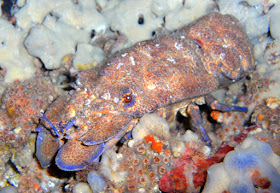After a few years of working as a Dive Instructor I became a little less meticulous in the recording of my dives.
I have logged Immersione No. 422 for the summer of 2012 where I worked on La Manga, Murcia in the South East of Spain. Unfortunately I can't find any record of the dives as detailed as those from my time in Cyprus and Mallorca. This was the very last of the hard copy logs that I kept before using Blogger for my dive records.
I worked for Neil Merry who was a fantastic guy and top diver.
Monday, 5 September 2011
Sunday, 24 July 2011
Sunday, 17 July 2011
Juvenile damselfish - Chromis chromis
Juvenile damselfish are beautiful little fish and extremely eye-catching due to their dazzling electric blue shine. They congregate in groups in rock crevices and under ledges.
Damselfish - Chromis chromis
Known as la castañuela in Spanish, this fish is extremely common in Mediterranean waters. They are generally found in shoals in midwater above or near rocky reefs or sea grass meadows. It is easily distinguished by its scissor shaped tail.
Saddled Seabream - Oblada melanura
Saddled Seabream are also called oblade and are an extremely common Mediterranean fish. It has a fuse-shaped silver body with a black spot near the tail.
Friday, 15 July 2011
Stingray - Spot them if you can!
As can be seen in the pictures, rays are very difficult to spot. With a careful and attentive eye you can just make out the eyes and its outline in sandbanks. There were areas where many stingrays could be found.
Monday, 27 June 2011
Cueva del Diablo (The Devil's Cave) Mallorca
The Devil's Cave dive profile.
There are two large chambers within the Devil's Cave. The first at the entrance was completely submerged whereas the second was filled with air and accessible through a tunnel running vertically to the surface.
The second chamber was impressive. There were numerous remains of candles which would have made the cave even more spectacular, however, the effect of our torches also offered its own alluring experience.
Saturday, 25 June 2011
The Skylight Cave, Mallorca
The Skylight Cave was one of my favourite dive sites.

With the opening directly above the cave system almost the whole cave was illuminated. On entering the cave, divers proceed to the middle of the cave below the skylight. The area on the far left of the diagram was unlit and required the use of torches. The group could then swim up at the back of the cave and surface in the top left corner. It is possible to stand in this area but with great care, many plants and organisms lived in this area and it would be a shame to recklessly crush them. The group could then swim back towards the skylight and swim down to the lower level.
A conger eel was regularly found in a crevice at the back of the Skylight Cave.
Part of the dive included showing the other divers the conger, if he was at home.
Friday, 10 June 2011
Entering el Cueva del Diablo
Monday, 6 June 2011
Barracuda - Sphyraena sphyraena
The Barracuda is a long ray-finned fish with prominent sharp fang-like teeth giving it quite a scary looking appearance. Some species can reach up to 1.8m in length.
Name: Barracuda
Order: Perciformes
Family: SphyraenidaeSunday, 5 June 2011
Saturday, 4 June 2011
Sarpa Salpa - Cow Bream
Sea Cucumber
This sea cucumber defends itself by expelling their sticky cuvierian
tubules to entangle potential predators. When touched or startled, these
cucumbers can expel them through a tear in the wall of the cloaca
(cakey button) in a process known as evisceration. Replacement tubules
grow back in one-and-a-half to five weeks, depending on the species.
On
finding such a Sea Cucumber it can be an extremely interesting sight.
You have to be careful not to get the tubules entangled on your
equipment or you'll spend the rest of the dive picking off the substance
which is very much like a spray of chewing gum.
The release of these tubules can also be accompanied by the discharge of a toxic chemical known as holothurin,
which has similar properties to soap. This chemical can kill any animal
in the vicinity and is one more way in which these sedentary animals
can defend themselves.
For more information, pictures and videos on evisceration visit the Echinoblog by ChrisM.
For more information, pictures and videos on evisceration visit the Echinoblog by ChrisM.
Watch this video for some humourously told facts about sea cucumbers:
The Cathedral and Three Caves, Mallorca
This was another of my favourite dive sites.
Confident divers could enter the cave on the right which descended down towards the left.
At the back of this cave, sometimes hidden by dead sea grass, was a little tunnel.
Entering this tunnel with lamps the group exited from the second cave.
The exit of the big cave (second from the right in the diagram)
Entering the middle cave
Lights out
The Cathedral

















































